选修六第二章第一节教案
选修六 unit2
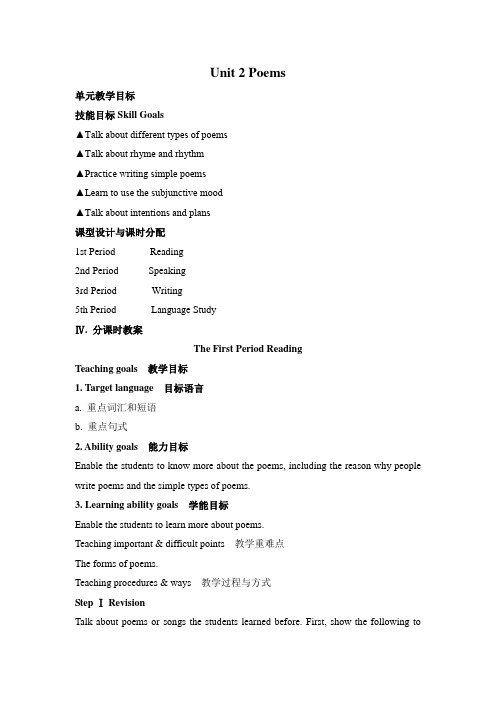
Unit 2 Poems单元教学目标技能目标Skill Goals▲Talk about different types of poems▲Talk about rhyme and rhythm▲Practice writing simple poems▲Learn to use the subjunctive mood▲Talk about intentions and plans课型设计与课时分配1st Period Reading2nd Period Speaking3rd Period Writing5th Period Language StudyⅣ. 分课时教案The First Period ReadingTeaching goals 教学目标1. Target language 目标语言a. 重点词汇和短语b. 重点句式2. Ability goals 能力目标Enable the students to know more about the poems, including the reason why people write poems and the simple types of poems.3. Learning ability goals 学能目标Enable the students to learn more about poems.Teaching important & difficult points 教学重难点The forms of poems.Teaching procedures & ways 教学过程与方式Step Ⅰ RevisionTalk about poems or songs the students learned before. First, show the following tothe students. (If possible, present them in audio-visual form.)Step Ⅱ Lead-inTask 1: Talk about the kinds of poems.Task 2: Ask the students to skim the poems in the Reading. Then tick the box.Step Ⅲ IntroductionTask 1: Ask the students to read the passage quickly and fill the form below.Task 2: Ask the students to listen to the recording of the passage and try clapping the beats.Task 3: Comprehending: Ask the students to answer the questions following the text. Task 4: Ask the students to know something about poems.Task 5: Ask the students to read the poems on page 52 in the workbook. Then answer the questions followed. (Encourage the students to comprehend the poems on their own.)Then ask the students to answer the first question on page 53 in the workbook.Step Ⅳ Homework1. Ask the students to collect at least five English poems with different forms.2. Ask the students to do Exercise 1 in Learning about Language on page 12.The Second Period SpeakingTeaching goals 教学目标1. Target language 目标语言a. 重点词汇和短语b. 交际用语What did it make you feel or ... P142. Ability goals 能力目标Enable the students to talk about poems.3. Learning ability goals 学能目标Help the students learn how to talk about poems.Teaching important & difficult points教学重难点How to talk about poems.Teaching procedures & ways 教学过程与方式Step ⅠRevision and Lead-inAsk the students to read the words aloud. Then ask them to explain why “rhyming” can make vocabulary easy?Step ⅡListening and SpeakingTask 1: Ask the students to listen to the poem “I’ve sav ed the summer”. And then answer the questions in Exercise 1.Ask the students to read the poem after the recording and circle the words that rhyme in the poem.Task 2: Ask the students to discuss about the poem.Step Ⅲ DiscussingTask 1: Ask the students to think about the kind of poem they would write / translate. Task 2: Ask the students to discuss the kind of poem they are going to write / translate.Step Ⅳ HomeworkAsk the students to write / translate the poems they talked about in the class.The Third Period WritingTeaching goals 教学目标1. Target language 目标语言重点词汇和短语load, translate, recite, poster, lyrics2. Ability goals 能力目标Enable the students to write / translate simple poems.3. Learning ability goals 学能目标Help the students learn how to write / translate poems.Teaching important & difficult points 教学重难点How to write or translate poems.Teaching procedures & ways 教学过程与方式Step Ⅰ RevisionAsk the students to show their work.Step Ⅱ WritingTask 1: Talk with the students about how to write list poems.Task 2: Ask the students to write a poem that starts with “I feel happy when ...” or “Slowly”.Step Ⅲ Homework1. Ask the students to do the exercises in Discovering useful structures on page 13.2. Ask the students to do Listening Task in the workbook on page 53.The Fifth Period Language StudyTeaching goals 教学目标1. Target language 目标语言重点词汇和短语nursery, rhythm, recite, run out of2. Ability goals 能力目标Enable the students to learn to use the subjunctive mood.3. Learning ability goals 学能目标Help the students learn how to use the subjunctive mood.Teaching important & difficult points 教学重难点The subjunctive mood.Teaching procedures & ways 教学过程与方式Step ⅠGrammar FocusTalk about “subjunctive mood”.Show the following to the students.Ask the students to read the following examples repeatedly. Step II HomeworkAsk the students to do the task in PROJECT.。
高二英语外研版选修六教学案:Module 2 Section 1 含答案
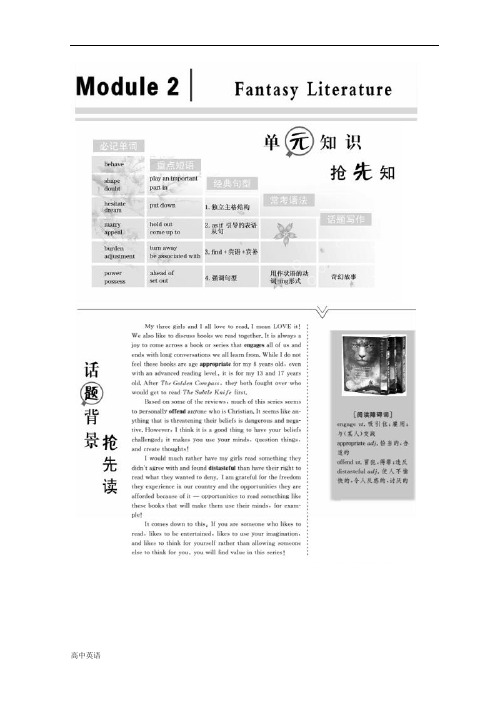
Ⅰ.Match the word with its meaning.1.series A.轻拍,轻打2.behave B.系列,丛书3.hesitate C.醒着的,清醒的4.doubt D.犹豫,迟疑5.direction E.做梦6.shape F.弯腰,屈身7.bend G.表现,举动8.dream H.形状9.awake I.方向10.pat J.怀疑答案:1~5 BGDJI 6~10 HFECAⅡ.Write down the meaning of phrases in each sentence.1.The examinee is then directed to fix on the examiner's right eye. 注视2.He kept/fixed his eyes on us without saying a word. 注视3.A child came up to me and showed me the way to the station.朝……走过来4.The police cast about for some fresh evidence. 寻找5.Hearing someone calling him, he looked around for the person. 四处寻找6.The air is laden with the scent of the flowers. 充满着7.Don't put the food down on the ground. 放下8.The lady held out her hand to him. 伸出9.She turned away in horror at the sight of so much blood. 走开10.She felt a wave of feeling sweep over her after hearing this. 向……扩展Look at the pictures.What are they?What do you know about His Dark Materials?参考答案:His Dark Materials, written by Philip Pullman, is one of the greatest fantasy stories ever written. It includes three books, Northern Lights, The Subtle Knife and The Amber Spyglass. The heroine is a young girl called Lyra and the hero is a boy called Will.Ⅰ.Fast readingMatch the following paragraphs with their main ideas.①Para.1 A.Will found where the cat had vanished.②Paras.2~7 B.Descriptions of the patch in the air.③Para.8 C.What he saw in another world.④Para.9 D.The strange behaviour of the cat.⑤Paras.10~11 E.Will went into another world.⑥Para.12 F.Will found a different world.⑦Paras.13~15 G.Will saw a cat.答案:①~⑦ GDABFECⅡ.Careful readingRead the text again and choose the best answer according to the text.1.Why did the author choose “The Cat That Vanished” as the title of this passag e? A.The cat was Will's loved pet cat.B.It was the cat that led Will to another world.C.The cat belonged to another world.D.The cat is said to have super power.2.What made Will curious about the cat?A.The time when the cat came to the garden.B.The cat's rubbing her head against his knuckles.C.The cat's strange behaviour.D.The territory for the cat to patrol.3.What did Will find after the cat vanished?A.Some angles.B.A patch in the air.C.A truck coming around the circle.D.Some houses.4.What did Will do after he climbed through the patch?A.He thought nothing was better than his home.B.He found a beautiful world with trees, flowers and a classical temple.C.The cat appeared again and acted as his guide.D.He was so sleepy that he fell asleep instantly.5.We can infer from the passage that .A.Will missed his family very muchB.Will realized that his dream could never come trueC.Will could never find the catD.Will didn't want to go back to his own world答案:1~5 BCBBDⅢ.Study readingAnalyze the following difficult sentences in the text.1.Of course, every cat behaved like that, but all the same Will felt such a longingto turn for home that tears scalded his eyes.[句式分析][尝试翻译] 当然,所有的猫都是那样的。
人教版选修6 Unit2 教案

Unit 2 RobotsTeaching aims(教学目标)三维目标知识目标Knowledge aims:1.Master the important new words,phrases and sentence patterns.2.To learn about some simple forms of English poems.3.To develop the students' reading ability by skimming and scanning the passage.4.To develop the students' speaking ability by talking about some features of some simple forms of English poems.5.Grammar in this unit: 虚拟语气(Subjunctive Mood)能力目标Ability aims:1.To learn the main developing steps of the history of English poetry.2.To learn the characteristics of different forms of poems.3.To improve students' reading ability.4.To practice writing simple poems.5.To guess what will be talked about in the listening materials.6.To improve their reading skills.7. Develop students’ reading ability and let them learn different reading skills.情感目标1.To cultivate students' appreciation of poetry and the ability of understanding,enjoying and writing poems.2.To develop students' sense of cooperative learning.3. Activate the students’interest of learning English by using many kinds of classroom activities. Important points(教学重点)1.Get students to know about different types of poems,some poetic devices like rhythm,rhyme,repetition,sound patterns and imagery.2.Have students learn some useful new words and expressions about poetry and let them learn effective ways to master them.3.Enable students to grasp and use the expressions of intention and plans.4.Let students learn the new grammar item:the subjunctive mood(2).5.Develop students' listening,speaking,reading and writing ability.Difficult points(教学难点)1.Enable students to master the use of the subjunctive mood.2.Let students learn to create their own poems.3.Develop students' integrative skillsTeaching methods(教学方法)1. Task-based teaching and learning2. Cooperative learning and practice3.Asking-and-answering activity to check the students’ answers of the exercises;individual,pair or group work to finish each task.4. Fast and careful reading.5. Discussion.Teaching aids(教具)(1)a tape recorder(2)a projector(3)the blackboard、whiteboard and other normal teaching tools学法指导合作探究对话推理教材分析本单元的中心话题是诗歌。
牛津译林版高中英语选修六Unit2WhatishappinesstoyouReading1教案
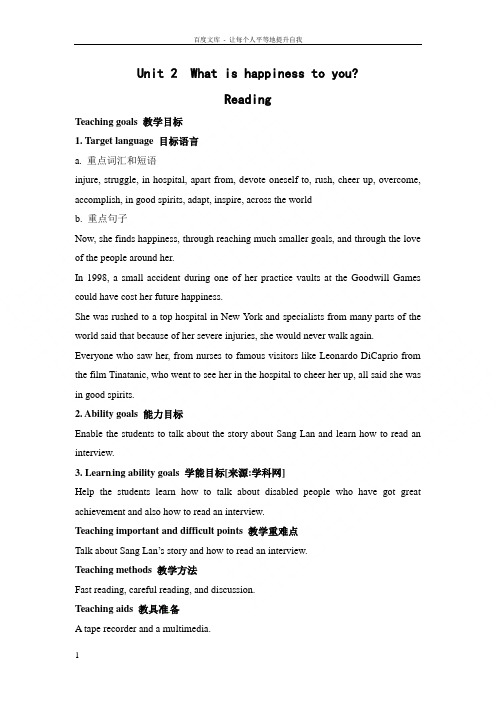
Unit 2 What is happiness to you?ReadingTeaching goals 教学目标1. Target language 目标语言a. 重点词汇和短语injure, struggle, in hospital, apart from, devote oneself to, rush, cheer up, overcome, accomplish, in good spirits, adapt, inspire, across the worldb. 重点句子Now, she finds happiness, through reaching much smaller goals, and through the love of the people around her.In 1998, a small accident during one of her practice vaults at the Goodwill Games could have cost her future happiness.She was rushed to a top hospital in New York and specialists from many parts of the world said that because of her severe injuries, she would never walk again. Everyone who saw her, from nurses to famous visitors like Leonardo DiCaprio from the film Tinatanic, who went to see her in the hospital to cheer her up, all said she was in good spirits.2. Ability goals 能力目标Enable the students to talk about the story about Sang Lan and learn how to read an interview.3. Learn ing ability goals 学能目标[来源:学科网]Help the students learn how to talk about disabled people who have got great achievement and also how to read an interview.Teaching important and difficult points 教学重难点Talk about Sang Lan’s story and how to read an interview.Teaching methods 教学方法Fast reading, careful reading, and discussion.Teaching aids 教具准备A tape recorder and a multimedia.Teaching procedures and ways 教学过程与方式Step ⅠGreetings and Lead-inGreet the stude nts as usual and get them to review what they have talked about in the last period.T: Do you remember what we talked about last time?Ss: Yes. We talked about happiness and how to become happy by discussing six pictures.T: Yes, that’s it. Usually, we become unhappy because of this or that, and can cheer up again with the help of our friends or parents. But have you ever thought about the disabled?S: They suffer a lot both physically and mentally.S: I think it is very difficult for them to do things.S: We should help them.…T: Quite right! However, there are many disabled people, who defeated unexpected difficulties and succeeded finally and set good examples to us. Can you give me some examples?S: Sima Qian in western Han Dynasty composed Shih Chi.S: Sun Zi, whose feet were cut, wrote the Art of War.S: Hellen Keller, who lost eyesight and hearing, entered Harvard and Cambridge to study and became a great writer and educator.[来源:学&科&网Z&X&X&K]…T: Well done! All these people encourage us so much. And if you suffered from what they had experienced, what would you do?S: I would push for success.S: I would do something I can to make my life colourful.S: I wanted to learn something.S: I would do something to help others. I always believe helping others can make ushappy.T: Great! All of you hold positive attitudes towards this. And today we will read an interview. The main character in the interview is Sang Lan. Do you know anything about her?S: I know she was once a gymnast.T: Yes, what’s more?S: She had an accident during one of her p ractice vaults and got injured severely.T: That is a shock to everyone. How did she overcome the difficulties, and how is she now? Let’s move to the text.Step ⅡFast-readingGet the students to read the text quickly and find out the answers to the questions in Part A.T: Now go through the text quickly, and answer the questions in Part A.[来源:]A few minutes later.T: Now who would like to answer the questions?S: The topic of the TV interview is about the search for happiness.T: That’s right. Next question: What’s the name of the psychologist?S: The psychologist’s name is Dr. Brain.T: Good. The last question: When and where was Sang Lan born?S: She was born in Ningbo, China in 1981.Step ⅢCareful-readingGet the students to read the text carefully and learn more detailed information and then do Exercise C.T: You have done a very good job in answering the three questions. And now I will give you some more minutes to read the text carefully. Then try to do True or False questions in C1 on Page 20. If the statement is wrong, please try to correct it.[来源:学科网]Several minutes later, check the answers together.T: Excellent! You have done a very good job.Step ⅣPost-readingGet the students to do Exercises C2, D, E and F.T: Now you have got a better understanding of the text. Next, let’s do some exercises. First, ask the students to glance at Exercise C2 and D, the read Reading part again to finish them.Several minutes later. Check the answers together.T: Well done! Now let’s look at Exercise E. This is a newspaper article about Sang Lan. I will give you several minutes to complete the article.[来源:学科网ZXXK] Several minutes later.T: Shall we check the answers now? I will ask some of you to read the article first. Ask some students to read the article and check the answers together.T: Well done! Next let’s talk about Exercise F in pairs, and la ter I’ll ask some of you to show us your dialogue. Are you clear?Ss: Yes!Give the students enough time to do that. Then check the answers.[来源:学科网ZXXK]Sample dialogue:A: Have you ever heard about the story of Sang Lan?B: Yes, of course! She is very famous in gymnastics, which is a dangerous sport, only top athletes should be allowed to try the most difficult moves.A: Why do you think so?B: Because these athletes, who could be chosen to take part in the inter national games, must be talents in this field. They are trained professionally and practice almost day and night, bearing tiredness, hardship, and other things that we have never thought about.A: I do think so. But I also think that even though we can not be the top athletes inthe world, training hard at a sport can make us more hard-working in other areas of our life.B: I can’t agree more. Training hard at a sport not only helps us build up our determination, challenge various difficulties bravely, and also helps us learn to collaborate with other team membe rs.[来源:学科网ZXXK]A: Yes. From the story of Sang Lan, we can find that the sport spirit can help her hold a positive attitude towards her life and the world.B: So, she keeps busy and thin ks about positive things to enrich her life.A: By doing so, she will think little about herself and more about others. When she recalls all these meaningful things she has done, she’ll be very happy.B: Quite right!Step V Discussion[来源:学+科+网]Enable the students to talk about their experiences to overcome the difficulties and become ha ppy.T: Up to now, we have learned the story about Sang Lan and her struggle for happiness. And what can we learn from her? Next, combine your own experience and discuss the questions with your partners. I will give you some minutes to finish the task.Show the students the following questions.1. Have you ever had some painful experiences?2. If you have, how did you search for your happiness?Give the students some time to discuss the questions in groups of four.During this period, the teacher may go into the students to give them help if necessary. After several minutes, check the answers.T: Well, time is up. Have you finished the discussion?Ss: Yes.T: OK. I’ll ask some of you to tell your stories.S: When I was twelve years old, I had a bad accident. I was knocked over by a car.After two months of treatment, I was nearly recovered. But I couldn’t stand up easily. So I had to sit in the wheelchair. It was a shock to me. I was so afraid to become disabled. During that period of time, I felt very frustrated. Fortunately, my parents and m y friends gave me much encouragement. They spared every free minute to stay with me and help me do exercise. Because of their encouragement and help, I cheered up again. I was determined to stand up again. Now I am as healthy as the others. After that experience, I realised that be optimistic, and everything will become better.T: Very good. You are brave. I believe in the future nothing will stop you. You will have a bright future.S2: To me, the most painful experience was the first month in the school. My home is far from here, so I had to be in residence(住校). I could meet my parents once a week. I felt so lonely. Everything was new to me. In that month, my study fell behind sharply. However, I thought, I couldn’t be like that any more. My aim was to get further education, not to miss my parents. So I concentrated on study. In my spare time, I tried to tal k with my classmates and made friends with them.Everything became better an d better afterwards.S: The painful experience I had was my failure in one exam. I had never failed in any exams before. That time I felt frustrated and even lost heart in my study. After a talk with my teacher, I realized: No pains, no gains. I looked back upon my attitude towards study before. Even the easiest things will become hard for you if you don’t try. So now I try my best to do everything. The results turn out that my effort is not in vain. I feel satisfied and happy.T: Good! You have expressed yourselves very clearly.Step ⅥText analysisHelp the students learn something about interview.T: The text we learned today is an interview. Can you tell me how to read an interview?[来源:学科网]S: First I will get the topic of the interview. And then I will read the questions and answers carefully.T: Good! Let’s read a reading strategy to know how to read an interview. Please open your books to Page 19.After several minutes.T: Can you tell me what an interview is?S: An interview takes place when one pe rson asks another person a series of questions on a topic.T: When reading an interview, what is important for us to do?S: It is important to carefully scan the first paragraph to find out the topic of the interview.T: What should we do after that?[来源:学.科.网Then we should carefully read each question and try to fully understand the question before reading the interviewee’s response.T: If we want to get a better understanding of the topic, what should we do?S: We should pay s pecial attention to the answer to the question.T: Thank you, very good. In this class, we learned Sang Lan’s search for happiness and we also learne d how to read an interview. Everyone did a very good job. Class is over.Step ⅦHomework1. Remember the new words and expressions.2. Retell the text.。
选修6unit2教学设计新部编版

教师学科教案任教学科:任教年级:任教老师:q %宀「紐八二V■:无工-a1 -.〕'二-pi厂二一 J :■••- ■,“•丿--• j--i ■=_•・a*応;j ■xx 市实验学校[20 -20 学年度第—学期]Book2 Unit 3 Comp uterReadi ng【学习目标】1. 语言目标 Language aims:1 )学会谈论电脑所用的有关单词和短语 :calculate, un iversal,sim plify, sum, op erator, logical, tech no logical, revoluti on, artificial, in tellige nee, solve, reality, person al, tube, n etwork, web, app licatio n, cinan ce, mobile, rocket, explore2)让学生了解计算机的历史和基本知识。
2. 能力目标 Ability aims:1) 进一步熟悉掌握一些阅读技巧,比如快速寻找文章细节信息 (scanning)、归纟内和总结(summarizing )。
2) 让学生学会表达自己的观点。
3. 情感目标 Emotional aims: 1) 引起学生学习电脑的兴趣。
2) 培养学生的合作学习能力。
重点 key P oi nts:1. let students learn more about history and basic knowledge of PC 。
2. Get stude nts to lear n differe nt read ing skills. 难点 important points:1. Devel op stude nts 'ead ing ability.2. En able stude nts to lear n to exp ress their opinions.二课时,第一课时完成导学案,第二课时小组安排代表展示。
选修六第二章第一节教案
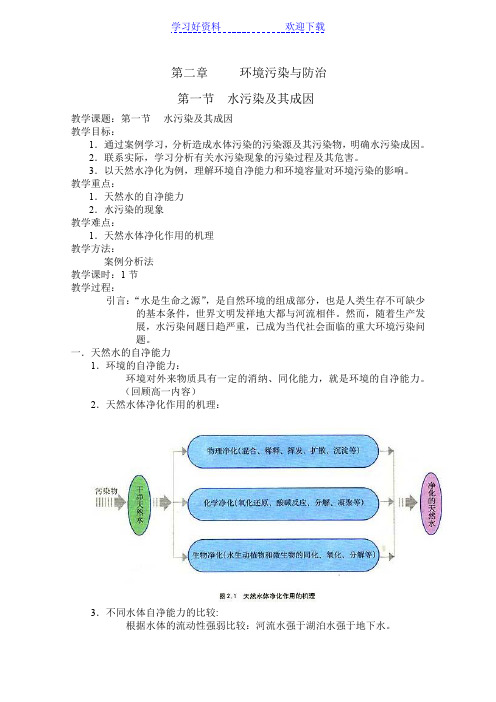
第二章环境污染与防治第一节水污染及其成因教学课题:第一节水污染及其成因教学目标:1.通过案例学习,分析造成水体污染的污染源及其污染物,明确水污染成因。
2.联系实际,学习分析有关水污染现象的污染过程及其危害。
3.以天然水净化为例,理解环境自净能力和环境容量对环境污染的影响。
教学重点:1.天然水的自净能力2.水污染的现象教学难点:1.天然水体净化作用的机理教学方法:案例分析法教学课时:1节教学过程:引言:“水是生命之源”,是自然环境的组成部分,也是人类生存不可缺少的基本条件,世界文明发祥地大都与河流相伴。
然而,随着生产发展,水污染问题日趋严重,已成为当代社会面临的重大环境污染问题。
一.天然水的自净能力1.环境的自净能力:环境对外来物质具有一定的消纳、同化能力,就是环境的自净能力。
(回顾高一内容)2.天然水体净化作用的机理:3.不同水体自净能力的比较:根据水体的流动性强弱比较:河流水强于湖泊水强于地下水。
掌握不同水体的自净规律,充分利用水体的自净能力,就能以最经济的方法控制和治理水污染。
4.水污染:在一定的时间、空间范围内,如果污染物大量排入天然水体,并超过其自净能力,就会改变水和底泥的理化性质,改变水中生物群落组成,造成水质恶化、水体利用价值降低甚至丧失的现象,称为水污染。
分析图 2.2二.水体污染现象1.水体污染物具有多样性,污染现象也不相同,主要污染现象有三种,归纳如下:水体富营养化导致水葫芦疯长:海洋富营养化导致赤潮:墨西哥湾石油泄漏:(1)墨西哥湾石油泄漏:(2)墨西哥湾石油泄漏:(3)墨西哥湾石油泄漏:(4)墨西哥湾石油泄漏:(5)2.水污染的主要污染源:3.主要污染物:课堂小结:布置作业:。
选修六第1-2章复习教案
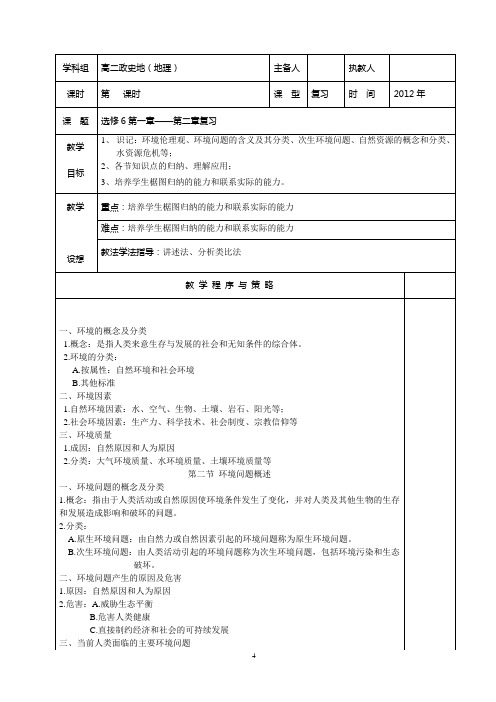
学科组高二政史地(地理)主备人执教人课时第课时课型复习时间2012年课题选修6第一章——第二章复习教学目标1、识记:环境伦理观、环境问题的含义及其分类、次生环境问题、自然资源的概念和分类、水资源危机等;2、各节知识点的归纳、理解应用;3、培养学生椐图归纳的能力和联系实际的能力。
教学设想重点:培养学生椐图归纳的能力和联系实际的能力难点:培养学生椐图归纳的能力和联系实际的能力教法学法指导:讲述法、分析类比法教学程序与策略一、环境的概念及分类1.概念:是指人类来意生存与发展的社会和无知条件的综合体。
2.环境的分类:A.按属性:自然环境和社会环境B.其他标准二、环境因素1.自然环境因素:水、空气、生物、土壤、岩石、阳光等;2.社会环境因素:生产力、科学技术、社会制度、宗教信仰等三、环境质量1.成因:自然原因和人为原因2.分类:大气环境质量、水环境质量、土壤环境质量等第二节环境问题概述一、环境问题的概念及分类1.概念:指由于人类活动或自然原因使环境条件发生了变化,并对人类及其他生物的生存和发展造成影响和破坏的问题。
2.分类:A.原生环境问题:由自然力或自然因素引起的环境问题称为原生环境问题。
B.次生环境问题:由人类活动引起的环境问题称为次生环境问题,包括环境污染和生态破坏。
二、环境问题产生的原因及危害1.原因:自然原因和人为原因2.危害:A.威胁生态平衡B.危害人类健康C.直接制约经济和社会的可持续发展三、当前人类面临的主要环境问题1.全球性环境污染:气候变暖、酸雨污染、臭氧层破坏等。
2.大面积的生态破坏:植被破坏、生物多样性减少、水土流失、土地荒漠化。
3.突发性的严重污染事件特点:突发性;污染范围大,危害严重,经济损失巨大。
第三节一、人类与自然环境的相互作用A.人类依赖于自然界而生存和发展;B.人类可以改造环境,环境又反作用于人类二、人类对自然态度的演变对自然的态度:依赖自然1.采猎文明时期:产生的环境问题:部分生物资源遭到破坏对自然的态度:改造自然2.农业文明时期:产生的环境问题:区域性环境问题出现对自然的态度:征服自然3.工业文明时期:产生的环境问题:环境问题蔓延的全球对自然的态度:善待自然4.后工业文明时期:产生的环境问题:全球性环境问题亟待解决三、人类与环境问题的和谐1.尊重和善待自然2.关爱人类并尊重个人3.兼顾当代人与后代人的利益第二章资源保护第一节自然资源与主要的资源问题一、自然资源的涵义1.概念:自然界中的各种物质和能量,只要他对人类有用的,都属于自然资源。
人教版高二英语选修6教案:Unit1+Art+period2(补充).doc
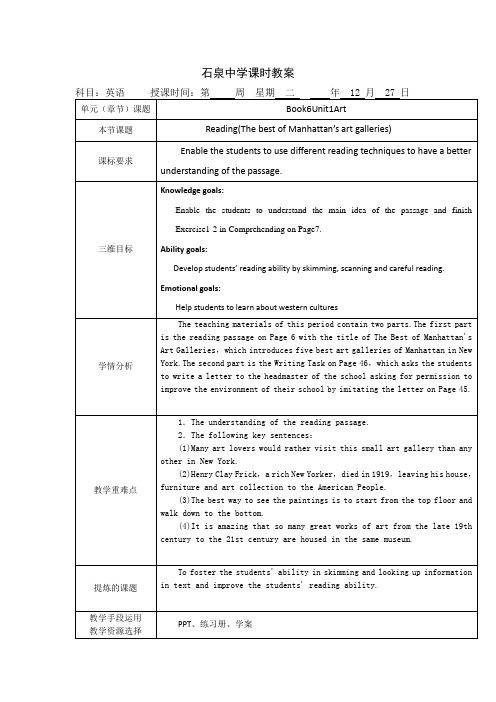
石泉中学课时教案Step 1RevisionCheck the answers to the grammar exercises on Page 5 and explain the difficult ones.p 2Lead-inGive the students a specific situation for the students to think and talk about some famous galleries.You may begin like this “Imagine your class is going to Beijing Arts and Crafts Gallery,and you are the guide of the gallery.Please tell them what they will be able to see in the museum.”Pre-readingGive the students the following two questions for them to think about and answer.1.Do you know any Western art galleries?2.Have you ever been to any Western galleries before? If so,describe your visit.Fast reading1.(Slide show)???Suggested answers:(1)The passage introduces some best art galleries of Manhattan.(2)Possibly in a guide book.(3)Tourists and art gallery visitors.Detailed readingRead the passage more carefully and complete the chart below.Suggested answers:Step 6Language studyShow the students the following language points in the passage in a slide show.1.appeal to(P6)【原句再现】It will appeal_to those who love Impressionist and Post-Impressionist paintings.展览将吸引印象派和后印象派作品的爱好者。
牛津译林版高中英语选修六Unit2Whatishappinesstoyouword教案
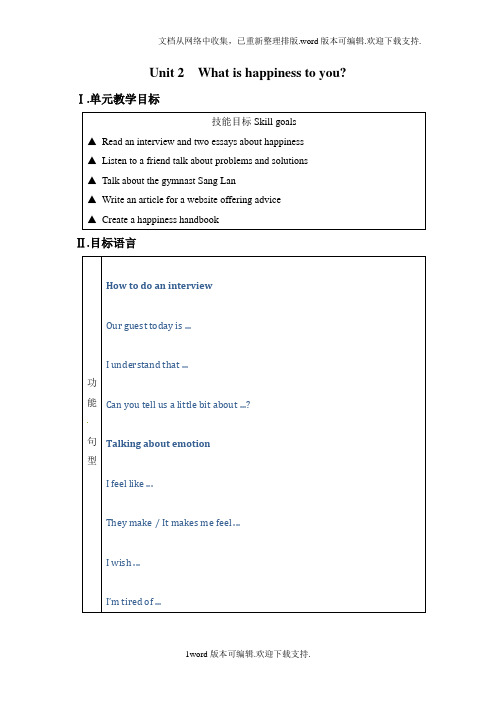
Unit 2 What is happiness to you? Ⅰ.单元教学目标技能目标Skill goals ▲Read an interview and two essays about happiness▲Listen to a friend talk about problems and solutions▲Talk about the gymnast Sang Lan▲Write an article for a website offering advice▲Create a happiness handbookⅡ.目标语言功能句型How to do an interviewOur guest today is ...I understand that ...Can you tell us a little bit about ...? Talking about emotionI feel like ...They make / It makes me feel ...I wish ...I’m tired of ...Asking for adviceHow can I help him?Do you think there is a solution?Is there a way to make everyone happy? Is there a solution he has not tried? Why does this work?词汇1.四会词汇injure, struggle, disability, simply, psychologist, gymnast, gymnastics, junior, tournament, event, energetic, apart, devote, rush, specialist, severe, cheer, hopeless, overcome, injure, obey, disappointment, accomplish, adapt, journalism, disabled, positive, optimistic, inspire, courage, admirable, rebuild, un bearable, unfortunate, sympathy, admiration, star, arrange, coach, allocate, adequate, confused, whichever, quit, unhappy, encouragement, guidance, golden, rush, independent, worry, innocent, income, adolescence, accomplishment, vivid, hunger, communicate, guarantee, workday, assist, automatic, instant, maximum, company, minimum, mature, secure, motivation2.认读词汇dedicated, vault3.词组in hospital, apart from, devote oneself to, cheer up, in good spirits, across the world, role model, believe in, be tired of, ahead of, at that point, in a rushher up, all said she was in good spirits. P199. Instead of crying about what she had lost and feeling hopeless, Sang Lanthought about what she could do to get better. P1910. When the doctors told her that she would never again be a gymnast, shewas able to overcome her disappointment and just be proud of the thingsshe had accomplished. P1911. All I had to do was go to school and spend a few hours studying when Icame home. P3012. It is hard to stay happy and cheerful when you are ill, or when you are oldand your body aches. P30Ⅲ. 教材分析与教材重组1. 教材分析本单元以What is happiness to you 为话题,展开什么是幸福、如何寻找幸福的讨论。
光的干涉》教案-新人教选修
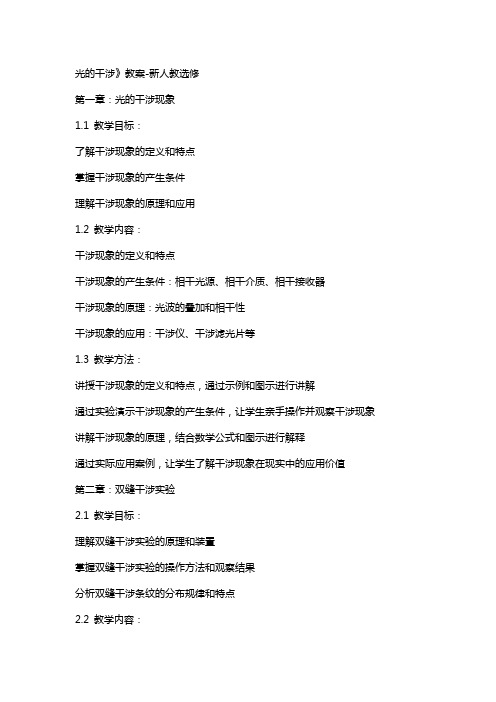
光的干涉》教案-新人教选修第一章:光的干涉现象1.1 教学目标:了解干涉现象的定义和特点掌握干涉现象的产生条件理解干涉现象的原理和应用1.2 教学内容:干涉现象的定义和特点干涉现象的产生条件:相干光源、相干介质、相干接收器干涉现象的原理:光波的叠加和相干性干涉现象的应用:干涉仪、干涉滤光片等1.3 教学方法:讲授干涉现象的定义和特点,通过示例和图示进行讲解通过实验演示干涉现象的产生条件,让学生亲手操作并观察干涉现象讲解干涉现象的原理,结合数学公式和图示进行解释通过实际应用案例,让学生了解干涉现象在现实中的应用价值第二章:双缝干涉实验2.1 教学目标:理解双缝干涉实验的原理和装置掌握双缝干涉实验的操作方法和观察结果分析双缝干涉条纹的分布规律和特点2.2 教学内容:双缝干涉实验的原理和装置:双缝、光源、屏板、滤光片等双缝干涉实验的操作方法:调整双缝间距、改变光源强度等双缝干涉条纹的分布规律和特点:等间距、对称、中心亮条纹等2.3 教学方法:讲解双缝干涉实验的原理和装置,通过图示和实物模型进行讲解演示双缝干涉实验的操作方法,让学生亲手操作并观察实验结果分析双缝干涉条纹的分布规律和特点,结合图示和实验数据进行讲解第三章:单缝衍射实验3.1 教学目标:理解单缝衍射实验的原理和装置掌握单缝衍射实验的操作方法和观察结果分析单缝衍射条纹的分布规律和特点3.2 教学内容:单缝衍射实验的原理和装置:单缝、光源、屏板、滤光片等单缝衍射实验的操作方法:调整单缝宽度、改变光源强度等单缝衍射条纹的分布规律和特点:非等间距、不对称、中心亮条纹等3.3 教学方法:讲解单缝衍射实验的原理和装置,通过图示和实物模型进行讲解演示单缝衍射实验的操作方法,让学生亲手操作并观察实验结果分析单缝衍射条纹的分布规律和特点,结合图示和实验数据进行讲解第四章:多缝干涉实验4.1 教学目标:理解多缝干涉实验的原理和装置掌握多缝干涉实验的操作方法和观察结果分析多缝干涉条纹的分布规律和特点4.2 教学内容:多缝干涉实验的原理和装置:多缝、光源、屏板、滤光片等多缝干涉实验的操作方法:调整多缝间距、改变光源强度等多缝干涉条纹的分布规律和特点:等间距、对称、中心亮条纹等4.3 教学方法:讲解多缝干涉实验的原理和装置,通过图示和实物模型进行讲解演示多缝干涉实验的操作方法,让学生亲手操作并观察实验结果分析多缝干涉条纹的分布规律和特点,结合图示和实验数据进行讲解第五章:光的干涉现象在现代科技中的应用5.1 教学目标:了解光的干涉现象在现代科技中的应用领域掌握光的干涉现象在现代科技中的应用原理和技术培养学生的创新意识和实践能力5.2 教学内容:光的干涉现象在现代科技中的应用领域:光学仪器、光电子技术、光学通信等光的干涉现象在现代科技中的应用原理和技术:干涉仪、干涉滤光片、干涉条纹等5.3 教学方法:讲解光的干涉现象在现代科技中的应用领域,结合实际情况进行讲解讲解光的干涉现象在现代科技中的应用原理和技术,结合图示和实物进行讲解开展实践活动,让学生亲手制作干涉滤光片等,培养学生的创新意识和实践能力第六章:干涉现象的数学描述6.1 教学目标:理解干涉现象的数学描述方法掌握干涉条纹的数学表达式和计算方法学习利用数学模型分析干涉现象6.2 教学内容:干涉现象的数学描述方法:叠加原理、相干函数、干涉条纹的数学表达式干涉条纹的计算方法:条纹间距、条纹对比度等参数的计算利用数学模型分析干涉现象:双缝干涉、单缝衍射、多缝干涉等6.3 教学方法:讲解干涉现象的数学描述方法,通过数学公式和图示进行解释学习干涉条纹的计算方法,结合实验数据进行计算练习利用数学模型分析不同干涉现象,让学生理解干涉现象的内在规律第七章:干涉现象的观测与测量7.1 教学目标:学会使用干涉现象进行观测与测量掌握干涉现象的观测工具和测量方法理解干涉现象在观测与测量中的应用7.2 教学内容:干涉现象的观测工具:光学显微镜、干涉望远镜等干涉现象的测量方法:干涉条纹的测量、干涉图的记录与分析干涉现象在观测与测量中的应用:长度测量、角度测量、折射率测量等7.3 教学方法:介绍干涉现象的观测工具和测量方法,通过实物展示和图示进行讲解学习干涉条纹的测量和干涉图的记录与分析,进行实际操作练习了解干涉现象在观测与测量中的应用,结合实际案例进行讲解第八章:干涉现象的科研与应用8.1 教学目标:了解干涉现象在科研中的应用领域掌握干涉现象在科研中的关键技术培养学生的科研素养和创新能力8.2 教学内容:干涉现象在科研中的应用领域:光学干涉成像、干涉光谱、干涉计量等干涉现象在科研中的关键技术:干涉仪的设计与制作、干涉数据的处理与分析开展科研实践活动,让学生参与干涉现象相关的科研项目8.3 教学方法:介绍干涉现象在科研中的应用领域,结合实际情况进行讲解讲解干涉现象在科研中的关键技术,通过图示和实物进行讲解开展科研实践活动,让学生亲手操作干涉仪器,培养学生的科研素养和创新能力第九章:光的干涉现象与环境9.1 教学目标:了解光的干涉现象与环境的关系掌握光的干涉现象在环境监测中的应用培养学生的环保意识和实践能力9.2 教学内容:光的干涉现象与环境的关系:大气污染、水污染等环境因素对光的干涉现象的影响光的干涉现象在环境监测中的应用:干涉仪在空气质量监测、水质监测等方面的应用开展环保实践活动,让学生参与光的干涉现象在环境监测中的应用9.3 教学方法:讲解光的干涉现象与环境的关系,结合实际情况进行讲解讲解光的干涉现象在环境监测中的应用,通过实例进行讲解开展环保实践活动,让学生亲手操作干涉仪器,培养学生的环保意识和实践能力第十章:光的干涉现象的未来发展10.1 教学目标:了解光的干涉现象的未来发展趋势掌握光的干涉现象在前沿领域的应用培养学生的创新意识和实践能力10.2 教学内容:光的干涉现象的未来发展趋势:光子计算、光子集成电路、量子干涉等光的干涉现象在前沿领域的应用:光子芯片、量子计算机、光子传感器等开展创新实践活动,让学生参与光的干涉现象在前沿领域的应用10.3 教学方法:讲解光的干涉现象的未来发展趋势,结合前沿科技进行讲解讲解光的干涉现象在前沿领域的应用,通过实例进行讲解开展创新实践活动,让学生亲手操作干涉仪器,培养学生的创新意识和实践能力重点和难点解析一、光的干涉现象的定义和特点:理解干涉现象的本质和特征,掌握干涉现象的产生条件。
高二英语外研版选修六教学案:Module 1 Section 2 含答案
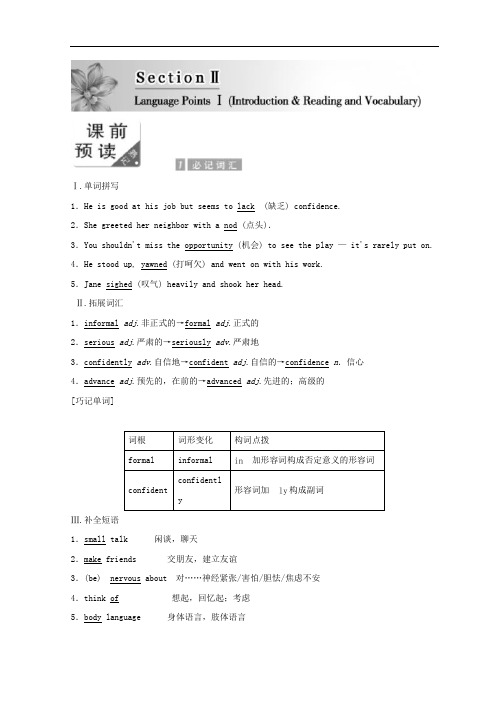
Ⅰ.单词拼写1.He is good at his job but seems to lack (缺乏) confidence.2.She greeted her neighbor with a nod (点头).3.You shouldn't miss the opportunity (机会) to see the play — it's rarely put on. 4.He stood up, yawned (打呵欠) and went on with his work.5.Jane sighed (叹气) heavily and shook her head.Ⅱ.拓展词汇1.informal adj.非正式的→formal adj.正式的2.serious adj.严肃的→seriously adv.严肃地3.confidently adv.自信地→confident adj.自信的→confidence n.信心4.advance adj.预先的,在前的→advanced adj.先进的;高级的[巧记单词]加形容词构成否定意义的形容词形容词加构成副词Ⅲ.补全短语1.small talk 闲谈,聊天2.make friends 交朋友,建立友谊3.(be) nervous about 对……神经紧张/害怕/胆怯/焦虑不安4.think of 想起,回忆起;考虑5.body language 身体语言,肢体语言6.look away from 把目光从……移开7.social rules 社交规则8.in addition 除此之外,另外9.find out 了解(到);找出(信息)1.[教材原句]And they are easy to learn.而且这些(技能)是很容易学习的。
[句型点拨]sb./sth.+be+adj.+to do。
[佳句赏析]橙汁很可口,也很容易做,并含有丰富的维生素。
高中英语选修六第二单元《Poems》参赛教案
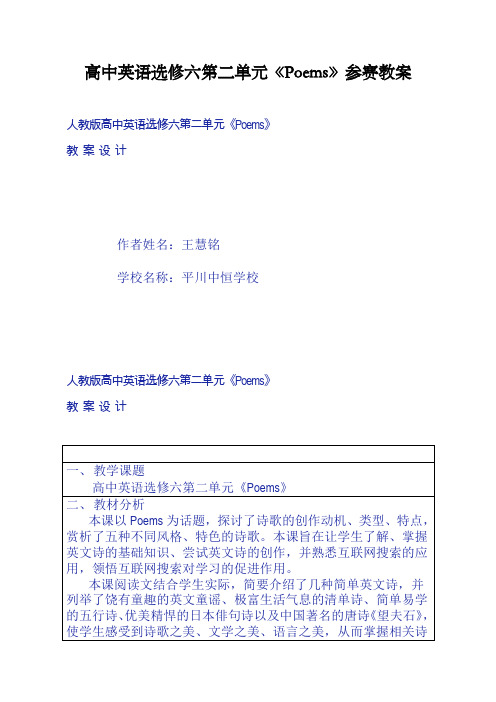
高中英语选修六第二单元《Poems》参赛教案人教版高中英语选修六第二单元《Poems》教案设计作者姓名:王慧铭学校名称:平川中恒学校人教版高中英语选修六第二单元《Poems》教案设计想学好英语,首先要培养对英语的兴趣。
“兴趣是最好的老师”,兴趣是学习英语的巨大动力,有了兴趣,学习就会事半功倍。
我们都有这样的经验:喜欢的事,就容易坚持下去;不喜欢的事,是很难坚持下去的。
而兴趣不是与生俱来的,需要培养。
有的同学说:“我一看到英语就头疼,怎么能培养对英语的兴趣呢?”还有的同学说:“英语单词我今天记了明天忘,我太笨了,唉,我算没治了。
”这都是缺乏信心的表现。
初学英语时,没有掌握正确的学习方法,没有树立必胜的信心,缺乏了克服困难的勇气,丧失了上进的动力,稍遇失败,就会向挫折缴枪,向困难低头。
你就会感到英语是一门枯燥无味的学科,学了一段时间之后,学习积极性也逐渐降低,自然也就不会取得好成绩。
但是,只要在老师的帮助下,认识到学英语的必要性,用正确的态度对待英语学习,用科学的方法指导学习。
开始时多参加一些英语方面的活动,比如,唱英文歌、做英语游戏、读英语幽默短文、练习口头对话等。
时间长了,懂得多了,就有了兴趣,当然,学习起来就有了动力和欲望。
然后,就要像农民一样勤勤恳恳,不辞辛苦,付出辛勤的劳动和汗水,一定会取得成功,收获丰硕的成果。
毕竟是No pains, no gains吗。
练好基本功是学好英语的必要条件,没有扎实的英语基础,就谈不上继续学习,更谈不上有所成就。
要想基本功扎实,必须全神贯注地认真听讲,上好每一节课,提高课堂效率,脚踏实地、一步一个脚印地,做到以下“五到”:一、“心到”。
在课堂上应聚精会神,一刻也不能懈怠,大脑要始终处于积极状态,思维要活跃、思路要开阔,心随老师走,听懂每一句话,抓住每一个环节,理解每一个知识点,多联想、多思考,做到心领神会。
二、“手到”。
学英语,一定要做课堂笔记。
因为人的记忆力是有限的,人不可能都过目不忘,记忆本身就是不断与遗忘作斗争的过程。
选修6第二单元阅读教案
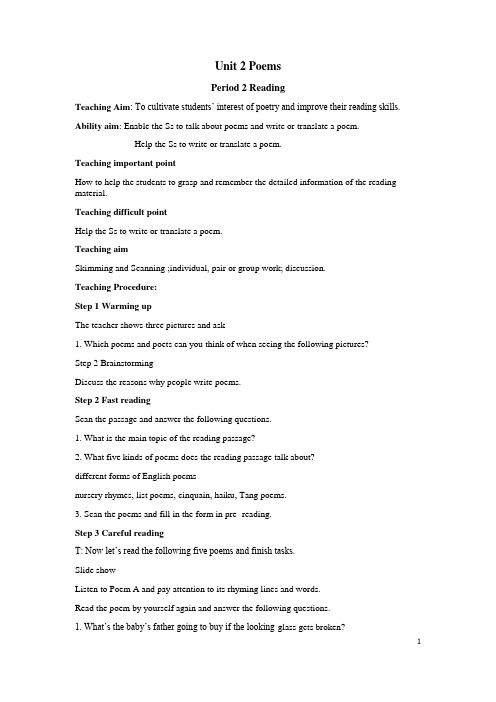
Unit 2 PoemsPeriod 2 ReadingTeaching Aim: To cultivate students’ interest of poetry and improve their reading skills. Ability aim: Enable the Ss to talk about poems and write or translate a poem.Help the Ss to write or translate a poem.Teaching important pointHow to help the students to grasp and remember the detailed information of the reading material.Teaching difficult pointHelp the Ss to write or translate a poem.Teaching aimSkimming and Scanning ;individual, pair or group work; discussion.Teaching Procedure:Step 1 Warming upThe teacher shows three pictures and ask1. Which poems and poets can you think of when seeing the following pictures?Step 2 BrainstormingDiscuss the reasons why people write poems.Step 2 Fast readingScan the passage and answer the following questions.1. What is the main topic of the reading passage?2. What five kinds of poems does the reading passage talk about?different forms of English poemsnursery rhymes, list poems, cinquain, haiku, Tang poems.3. Scan the poems and fill in the form in pre- reading.Step 3 Careful readingT: Now let’s read the following five poems and finish tasks.Slide showListen to Poem A and pay attention to its rhyming lines and words.Read the poem by yourself again and answer the following questions.1. What’s the baby’s father going to buy if the looking-glass gets broken?12. What is Papa going to buy for the baby if that billy-goat runs away?3. What are the features of it?Keys:1. a billy -goat2. another billy-goat3. It has strong rhythm and rhyme and has a lot of repetition.Poem CRead the poem C and answer the follow questions1. Did his or her team win the game?2. Why his or her team didn’t win the game?3. Does the speaker really believe his or her own excuse? How do you know?Keys:1. No, his or her team didn’t win.2. The players didn’t win because: Jack didn’t score that goal; they didn’t have enough time; they hadn’t trained hard….3. The speaker does n’t really believe his or her own excuses, because there has too many ifs…Poem D&E1. What subject is the speaker writing about?2. Does the speaker like the subject? Give a reason for your answer.T: We have enjoyed so many English poems. Some are traditional forms of English poetry but some are not, for example haiku. (It comes from Japanese).In fact English speaker also have borrowed from another kind of Asian poetry---Tang poems from China. Poem H at the bottom of this passage is a translation from the Chinese.The translation of Poem H望夫石王健望夫处,江悠悠。
选修六教案

Unit 1 Art 总第教案课型:单元备主备人:李鹏飞审核人:刘传宝一、地位与作用本单元以本单元以art 为主题,主要介绍了西方绘画简史,描写了曼哈顿最好的艺术长廊。
帮助学生了解更多的有关美术的背景知识,分析中西艺术史上各大流派的特点,指出其代表性的画家和作品,并对中西方的绘画艺术进行比较。
通过本单元的语言技能训练,要求学生学会使用请求以及感谢的表达法。
二、模块划分1. warming up 部分要求学生运用相关目标语言对自己喜欢的艺术形式和流派展开讨论,并说明喜欢的原因。
In this section teachers can lead in the topic of this unit by showing them some paintings to review their knowledge and present their opinions about the paintings.2. pre-reading 让学生讨论有关画展或书中的艺术作品以及西方不同时期的著名画家。
While learning this part, teachers had better hold a small discussion with several students to arouse the sudents’ desire to learn about the Western art. Meanwhile ask the students to look at the paintings on P2 and and try to recognize them and indentify which style they belong to.3.reading 介绍了西方绘画监视,不同的艺术流派,艺术特点及其代表性的画家和作品。
In this part, teachers may first ask the students to read the text quickly to finsh a multiple chioce, Then read the text to learn about the different characteristics of different styles of Western paintings and discuss how the text is organized. 4.comprehending要求学生在理解课文的基础上,写出三件有关西方艺术史的事并西方艺术分割变化大的原因。
2020届一轮复习人教版选修6Unit2PoemsPeriod1Reading教案设计(12页word)

2019届一轮复习人教版选修6Unit2PoemsPeriod1Reading教案设计(A FEW SIMPLE POEMS OF ENGLISH POEMS)IntroductionIn this period, after the warming up, students will first be guided learn about English poets and their poems. Then they will read an expository piece by means of reading aloud to the recording, understanding formsof English poems, reading and underlining, reading aloud and translatingand writing a poem of their own. The class is to end by students taking a quiz.Objectives■To help students learn to express intention■To help students learn to read an exposition about poems■To help students better understand “poems”■To help students learn to use some important words and expressions■To help students identify examples of “Subjunctive Mood (2) If I had done…,I w ould have done…” in the textFocusAidsMultimedia facilities, tape-recorder, photos, diagramsProcedures1. Warming up⑴Warming up by reciting poemsHi, class. We are to take up Unit 2 Poem. Can you remember any poems you have read in high school, either in Chinese or In English? How many poems can you recite now? Let’s try this one.Mid-Autumn MoonSu ShiSunset cloud gather far excess clear cold Milky Way silent turnjade plate This life this night not long The sunset clouds are gathered far away, it's clear and cold,The Milky Way is silent, I turn to the jade plate.The goodness of this life and of thisgood Next year bright moon where see night will not last for long,Next year where will I watch the bright moon?⑵Warming up by sharing informationMorning class! How much do you know about Chinese poets? How many poets have you ever read? Now in groups of 4 list all poets that you have heard of or read of.Featured poets from ChinaBai Juyi (白居易) uses very simple language, and is thereforeparticularly accessible for the beginner.Du Fu (杜甫) widely acknowledged as the finest of theclassical Chinese poets. His poems have aparticularly sensitive feeling for humanity.Du Mu (杜牧) one of the foremost writers of the late Tangperiod.Li Bai (李白) the most popular Chinese poet, with adistinctively Romantic style.Li Shangyin (李商隐)wrote verse which was allusive, but whichnevertheless dealt with readily accessible themesof loss and parting.Li Yu (李煜) the last emperor of the Southern Tangdynasty, deposed in 975. His works focuson the memory of lost pleasures.Liu Zongyuan (柳宗元) a Mid-Tang politician and another victimof political intrigues. Meng Haoran (孟浩然) associated with Wang Wei, and was himself one of the greatest poets of the High Tang.Su Shi (苏轼) also known as Su Dongpo, was the most importantof the Song dynasty poets. .Wang Wei (王维) one of the three most admired Tang dynasty poets,alongside Du Fu and Li Bai. A painter as well as apoet, he is known above all for his miniaturistcelebrations of nature.⑶ Warming up by brainstorming for reasons why people write poems So why do people write poetry? The reasons are as numerous as the poems themselves. Some people want to: make nice with the gods, tell the stories of their communities, record history, commemorate a moment of personal history, take an achingly clear snapshot of experience, embody their feelings, create a state of feeling and explore language.2. Pre-reading by learning about English poets and their poemsThis is my personal English poetry anthology; I hope it will give you, dear students, great pleasure in reading; perhaps as much as it gave me in (re-)citing the poems from memory. I learned many of these poems by rote 10 years ago as a schoolboy. Schoolchildren nowadays do not learn poems as much by rote as we did then.My favorite English poems3. Reading⑴Reading aloud to the recordingPoems are written to be read aloud. So first let’s listen and read to the recording of the text. Listen carefully and read correctly.⑵Understanding forms of English poemsTo understand poems better we shall talk about forms of poems first.⑶Reading and underliningRead the text once again and underline all the expressions useful to you. Copy them in your note book after school as part of homework.⑷Reading and transferringSkim the text and complete the table below.(5)Making a diagram to show the meaning and organization of the text(6)Reading aloud and translatingTo better understand the feeling expressed, we sometimes translate the poems into Chinese. Try the following one.4. Writing a poem of your ownCould you be a poet? Now try to write a poem in English or Chinese. And in groups of four read it aloud in turns. The best one will be shared in class.5. Closing down by taking a quiz。
人教版高中英语选修6 Unit1 Period2 优秀教案
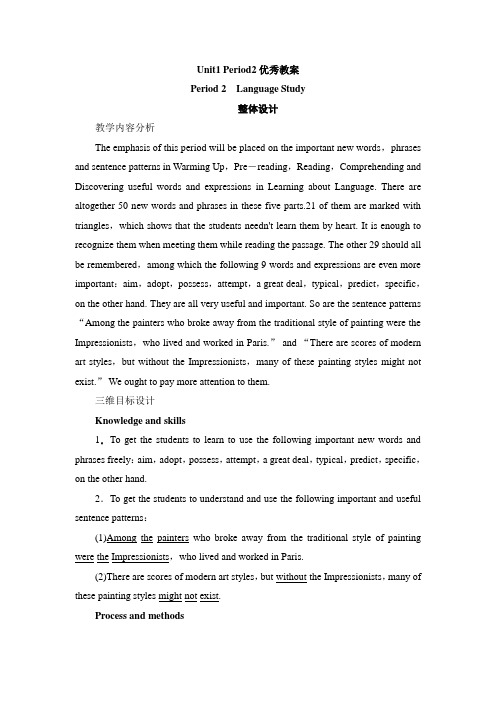
Unit1 Period2优秀教案Period 2Language Study整体设计教学内容分析The emphasis of this period will be placed on the important new words,phrases and sentence patterns in Warming Up,Pre-reading,Reading,Comprehending and Discovering useful words and expressions in Learning about Language. There are altogether 50 new words and phrases in these five parts.21 of them are marked with triangles,which shows that the students needn't learn them by heart. It is enough to recognize them when meeting them while reading the passage. The other 29 should all be remembered,among which the following 9 words and expressions are even more important:aim,adopt,possess,attempt,a great deal,typical,predict,specific,on the other hand. They are all very useful and important. So are the sentence patterns “Among the painters who broke away from the traditional style of painting were the Impressionists,who lived and worked in Paris.” and “There are scores of modern art styles,but without the Impressionists,many of these painting styles might not exist.” We ought to pay more attention to them.三维目标设计Knowledge and skills1.To get the students to learn to use the following important new words and phrases freely:aim,adopt,possess,attempt,a great deal,typical,predict,specific,on the other hand.2.To get the students to understand and use the following important and useful sentence patterns:(1)Among the painters who broke away from the traditional style of painting were the Impressionists,who lived and worked in Paris.(2)There are scores of modern art styles,but without the Impressionists,many of these painting styles might not exist.Process and methods1.To help the students to understand the meanings of the above useful new words and expressions in the context,and then give some explanations about them,and at last offer some exercises to make students master their usages.2.To ask the students to make up their own sentences by imitating the above sentence patterns.3.At the end of the class,make students do more exercises for consolidation.In doing so,they can learn,grasp and use these important language points well.Emotion,attitude and value1.To stimulate students' interest in learning English.2.To develop students' sense of cooperation and teamwork.教学重、难点1.Important new words and expressions:aim,adopt,possess,attempt,a great deal,typical,predict,specific,on the other hand.2.Important and useful sentence patterns:(1)The inverted sentences beginning with a prepositional phrase.(2)The subjunctive mood with a prepo sitional phrase “without...” in place of the “if” clause.3.Some difficult and long sentences in the text.教学过程Revision1.Check the homework exercises.2.Ask some students to tell the styles of Western art.Reading and findingGet students to read through Warming Up,Pre-reading,Reading,Comprehending and Learning about Language to underline all the new words and useful expressions or collocations in these parts. Read them aloud and copy them down in the exercise book.Practice for useful words and expressions1.Turn to Page 4.Go through the exercises in Discovering useful words and expressions with students and make sure they know what to do.。
选修六第二单元教案
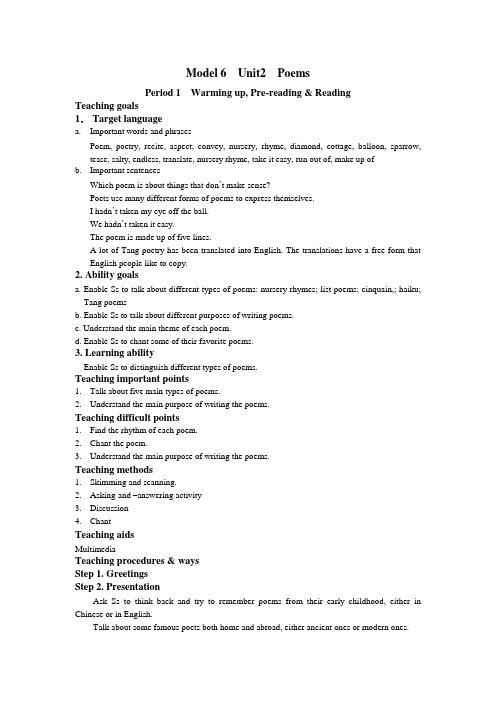
Model 6 Unit2 PoemsPeriod 1 Warming up, Pre-reading & ReadingTeaching goals1.Target languagea.Important words and phrasesPoem, poetry, recite, aspect, convey, nursery, rhyme, diamond, cottage, balloon, sparrow, tease, salty, endless, translate, nursery rhyme, take it easy, run out of, make up ofb.Important sentencesWhich poem is about things that don‟t make sense?Poets use many different forms of poems to express themselves.I hadn‟t taken my eye off the ball.We hadn‟t taken it easy.The poem is made up of five lines.A lot of Tang poetry has been translated into English. The translations have a free form thatEnglish people like to copy.2. Ability goalsa. Enable Ss to talk about different types of poems: nursery rhymes; list poems; cinquain,; haiku; Tang poemsb. Enable Ss to talk about different purposes of writing poems.c. Understand the main theme of each poem.d. Enable Ss to chant some of their favorite poems.3. Learning abilityEnable Ss to distinguish different types of poems.Teaching important points1.Talk about five main types of poems.2.Understand the main purpose of writing the poems.Teaching difficult points1.Find the rhythm of each poem.2.Chant the poem.3.Understand the main purpose of writing the poems.Teaching methods1.Skimming and scanning.2.Asking-and –answering activity3.Discussion4.ChantTeaching aidsMultimediaTeaching procedures & waysStep 1. GreetingsStep 2. PresentationAsk Ss to think back and try to remember poems from their early childhood, either in Chinese or in English.Talk about some famous poets both home and abroad, either ancient ones or modern ones.Brainstorming: What will you think of when we talk about the word “poem”?Step 3. Warming upRead the questions in this part, reminding Ss what they notice about the above poems.(e.g. they have a strong beat, or they have rhyme, or they play with words and sounds, or perhaps some of them are funny because they make no sense.)Tell Ss that there are many reasons why people write poetry. Give the examples on the Bb. Ask Ss why they think the poets wrote the poems they have just recited.. Write their suggestions on the board.Give Ss a time limit of a few minutes. Divide the class into groups of four to discuss the purpose of writing poems. Ask one person from each group to read their group‟s list and add their suggestions to the list on the board. (Suggested reasons: to create certain feelings or images in the reader; to share a feeling or experience; to describe something in detail or give an impression; to get the reader to think about an idea; to express a point of view; to make the reader experience the sight, sounds, smells, feel and tastes of something; to create a mood, to play with words--- their sounds, rhyme and rhythm.)If time permits, in small groups or as a class, discuss the kinds of topics that poets write about.( people, animals, nature, landscapes, the sea, the seasons, stories, death, war, youth and old age, feeling and experiences, emotions like love, hate, sadness, regret and desire, etc.)Step 4. Pre-readingPeople from different countries write different kinds of poems. Get Ss to discuss the questions on Page 9 with their partners: Do you have a favorite poem in Chinese? Why ? Do you have a favorite poem in English? Why?As to exercise 2, give Ss practice in an important reading skill: scanning a text, that is, looking through a text quickly to find specific information. Read the table in exercise 2 with the Ss. Tell them that they are going to look for the information in the table, just in the poems themselves, not in the other parts of the text. They are to look only for those pieces of information and not read every word. Do an example with them.Suggested answers to exercise 2:Which poem A B C D E F G Hdescribes a person? √tells a story? √describes an aspect of a season? √√√is about sport? √is about things that don‟t make sense? √is recited to a baby? √describes a river scene? √has rhyming words at the end of lines? √√repeats words or phrases? √√√Step 5. ReadingScanningGet the Ss to read the passage quickly and accurately and meanwhile help the Ss to form a good habit of reading. Teacher gives Ss a couple of minutes to look through the whole passage.Tell them to read the text silently and then ask some detailed questions about the text on the slide show . Teacher should encourage Ss to express their ideas.Q1. Why do people write poetry?Q2. How many forms of poems are mentioned in the passage? What are they?Q3. What does “nursery rhyme” mean? Why do they delight small children?Q4. What‟s the characteristic of “list poems”? What about “cinquain”?Q5. Why do English People like “Haiku”?Q6. Are you familiar with Tang Poems? Do you know the title of the last poem in the text? ListeningBefore Ss read the text, have them close their books and listen to the text with their eyes closed. This gives Ss the opportunity to listen to the sounds or “music”of the poems before reading them in detail. Tell them that it doesn‟t matter if they don‟t understand every word.First readingGet Ss to read the text carefully, finding the one sentence that sums up the paragraph of each part.. Underline the topic sentence.Second readingTell Ss that they are going to look at the rhythm of two of the poems. Make sure they know what rhythm is. Read the limerick aloud and have Ss listen for the strong beats. Then have them clap the strong beats as you read. Mark the strong beats on the limerick on the board.There was an old man with a beardWho said “it is just as I feared”.“Four in sects and thenTwo birds and a henHave all made a home in my beard”.Now read the poem A & B. Ask them to mark the strong beats on the two poems that have a strong rhythm. Check their answers . Then play the tape and get them to clap to the strong beats in those two poems.Third readingJust as any scene can serve as the subject of a painting, so any part of daily life can provide material for a poem.. Of course, the choice that the artist or poet makes relates to his or her purpose. Poetry is usually short and compact, so it should be read several times, preferably aloud, to appreciate its meaning. Read the last poem (Poem H), and answer the following questions:Q1. What parts of the poem suggest that the woman loves her husband?Q2. How do you understand the sentence”Should the journeyer return, this stone would utter speech.”? Explain the sentence in your own words.Q3. What picture do you have in your mind when you read the above sentences?Q4. Do you know the Chinese title of this poem? Do you know the Chinese version of the poem? Step 6. Make a short summary of this period.Homework1.Surf some websites to find out more information about poets.2.Review the content of the reading passage.3.Finish the exercises on Page 12& 13.Period 2 Reading, Comprehending & Learning about language Teaching goals1.Target languageImportant words and phrasesjoy, anger, sorrow, thread, appropriate, ending, compass2. Ability goalsEnable Students to deepen their understanding of the reading passage and learn some useful words and expressions.Learn to use words and expressions in their right form.3. Learning abilityEnable Ss to understand the rhyme and rhythm in English poems.Teaching important points1.Understand the passage and answer the questions about it.2.Learn the useful words and expressions in the passage.Teaching difficult points1.Discuss the poems and understand their deep meaning.2.Find the rhyme and rhythm in English poems and try to create them by students themselves. Teaching methodsDiscussion, asking-and-answering activity, practice, task-based activity Teaching aidsMultimediaTeaching procedures & waysStep 1. GreetingStep 2. ComprehendingTask 1. Group workAsk students to read the passage together and then discuss in group which poem they like best and give reasons.After discussion, ask someone to present his/her idea to the class.Task 2. Ask and answerAnswer the questions about the passage on Page 11 – 12.Step 3. Explanation1.Others try to convey certain emotions.“convey” here means communicate (an idea, meaning, etc.).I can’t convey how angry I feel.“emotion” means strong feelingLove and hatred are basic emotions.His voice was shaking with emotion.2.They delight small children because they have strong rhythm and rhyme.“delight” means make sb. pleased greatly.The gift of the child delighted his parents.I am delighted to help you.“rhythm” means a measured flow of words and phrases in verse determined by various relations of syllables.the exciting rhythms of African drum music“rhyme”means identity for sound between words or the endings of words, esp. in verse.Shakespeare sometimes wrote in rhyme.He made up funny rhymes to make us laugh.3.We would have won if we hadn‟t taken it easy.“take it easy”means to proceed gently or carefully; to relax and avoidoverwork.You’ve done quite enough work for today; now take it easy for an hour.4.We would have won if we hadn‟t run out of energy.“run out(of sth.)” means to use up; to come to an end.The petrol is running out.We are running out of out time. = Our time is running out.5. a poem made up of five lines“make sth. up” means to put together; to compoundWhat are the qualities that make up his character?Society is made up of people of widely differing abilities.Step 4. Learning about languageCheck the exercise on Page 12-13.Task 1. Discovering useful words and expressions1.Ask some students to list the words they find to rhymes with the words in theexercise. The teacher may make some addition if necessary.Sample answers:2 high sky pie my fly shy lie3 sing ring wing thing king fling string4 today away say play lay tray may5 lace race face case chase place pace6 true too new flew few shoe canoeAsk students to try to create more lists by themselves.plete the passage using the correct words.Ask students to finish the passage and explain why the form of the words must be changed.Task 2. Discovering useful structures1.Rewrite the poem about winning the match and the reasons.2.Rewrite the poem about the attempt to win the competition.Offer students some time to discuss about it and present some samples for them to follow if they find it difficult to get through.3.Match the sentences.Explain some rules of subjunctive mood if necessary.plete the sentences using the correct forms of the verbs.Step 5. Using words and expressions(Workbook)Task 1. Make adjectives from nouns by adding suffix “ful” and then explain the meaning of the new adjectives. Encourage students to think of more examples that have the same form.Task 2. Complete the table with the correct words.Noun Verb Adjective AdverbTask 3. Complete the sentences using the correct word from the table.Task 4. Match the phrases appropriately and encourage students to create more of their own word pictures.Step 6. Make a short summary of this period.Homework1.Remember important language points.2.Write a simple English poem by using rhyme and rhythm.3.Preview “Learning about language”.Period 3 Learning about LanguageTeaching goals1.Target languagea.Important wordsAppropriate , ending , compassb.Important sentencesIf she had stueide harder , she would have passed the exam.If she had been there , she would have met some really interesting people.2. Ability goalsa. Enable Ss to grasp the ways of writing poems.b. Enable Ss to use subjunctive mood correctly.3. Learning abilityTeach Ss how to write some poems and how to use subjunctive mood correctly.Teaching important points1.the way of writing poems.2.Subjunctive MoodTeaching difficult pointsUsing subjunctive mood correctly in different situations.Teaching methods1.Task-based learning2.instructions3.practiceTeaching aidsMultimediaTeaching procedures & waysStep 1. GreetingsStep 2. Warming upTask1: Free talk------ why do you enjoy learning English?T: I‟m glad to see you again and I‟m happy because we can enjoy English together. Do you enjoy learning English?S: Yes . Because English is a very beautiful language.S2: Because we can enjoy a lot of funny stories if we know English.S3: Because we can communicate with foreigners in English.S4: Because we can introduce China to foreigners if we know English.S5……T: Well done. If we did well in some way , people would know us. Now let‟s talk about some famous persons. (Yao Ming , Liu Xiang , Madame Curie, Yuan Longping, Chinese Women Football Team)Step 3. PresentationTask2: Group talk-----Try to talk about the famous persons.Q1: Why is Yao Ming famous ? S1: Because he played basketball very well. S2:…..Q2: Why could Liu Xing succeed ? S1: Because he trained very hard. S2:……..Q3: Why did Chinese Women Football Team lose the game? S1: Because they were tired…Q4: Complete the sentence : They would win if they ………S1:They would win if they had a good rest. S2:……T: Just now we talked a lot about some persons .If we put these sentences together , they formed a kind of poem-----list poems..Task3: Turn to page 13 , and do exercises 1 and 2.Step 4. GrammarTask4: Present some sentences on the blackboard , and ask Ss to tell the difference among them.a.If I knew it , I would tell you.b.If I had known it yesterday , I would have told you .c.If I had known it , I would have told you.d.If I had finished my homework , I would have gone to bed.e.If I had known his telephone number , I would have made a phone to him.S1: In these sentences , they use different tenses.S2: They describe different situations.S3:…………T: Yeah . We can draw a conclusion as follows:Verb formsIf –clause The main sentenceThe present situation Ved would /could/should/might +V The past situation had Ved would/could/should/might+have VedTask5: Compare some special sentences and draw a conclusion.A. Had I not seen it with my own eyes , I would not have believed it.Were it not to rain tomorrow , we would have a picnic.Should it rain tomorrow , we would have a picnic.Conclusion: connect subjunctive mood with inversion.B. If the weather had been finer, the crops would be growing still better.If you had followed the teacher‟s advice, you wouldn‟t be in hospital.Conclusion: The situations in the clause and the main sentence are different.C. If only I knew his name!If only we had followed your advice!If only I could see him again!Conclusion: We should use different forms of verbs according to the different situations in the pattern: If only.D. Without sunlight, people‟s life wou ld be different from today.But for your help, I wouldn‟t have finished the work.Conclusion: If there are some special prepositions just like without , but for in the sentences, we sometimes should use subjunctive mood.Step5. PracticeTask6 : Do exercises 3 and 4 on page13.Task7: Present some pictures and ask Ss to make up some sentences with subjunctive mood. Picture1: A rockete.g •If I were a designer , I would design a spaceship .•If I were clever enough , I would have designed a spaceship.Picture2: the universee.g.:•If I were an astronaut , I would travel into space.•If I had been to space , I would have known what were there in space.Picture3:a lot of moneye.g.:•If I had a lot of money , I would run a big company.•If I had earned a lot of money , I would have built a lot of houses for the poorPicture 4:the farmer and the snakee.g.:•If the farmer hadn‟t seen the snake , he wouldn‟t have put it in the arms.•If he hadn‟t put it in the arms , the snake wouldn‟t have bitten him.•If the s nake hadn‟t bitten him , he wouldn‟t have diedTask8: Do some exercises on screen.Step6: summary and homeworkDo exercises 1-4 on page 50 and 51.Period 4 Reading , Listening and WritingTeaching goals1.Target languagea. key words and phrases: pattern, rhythmic, rhyme, rhythm, sunlight, darkness, warmth, underlined, loadb. key sentences:I‟m not going to do….I plan to do…I‟ll do….I am looking forward to do…..If I were the ruler of the world, I would do….If I had a million dollars, I would do….I feel happy when….Slowly the moon climbs in the sky….2.Ability goalsa. Enable the students to understand the rhyme and rhythm of the poem and grasp the main idea.b. Enable the students can get the information from the long passage by listening.c. Enable the students can express their feelings by writing poems.3. Learning ability goals:a. Enable the students to know how to get the key words to understand the poem.b. Enable the students can find where the rhyme and the rhythm of the poem are.c. Help the students learn how to get some skills in listening.d. Enable the students to learn to present enough reasons to support their opinions.e.. Help the students learn to write poems using the target language according to the writing steps.4.Teaching important pointsa. Help the students to understand what the rhyme and rhythm are.b. Train the students to get the key words by reading the question before listening.c. Teach the students to write according to the writing steps.5.Teaching difficult pointsa.How to help the students can find where the rhyme and the rhythm of the poem are.b.How to help the students to make up dialogues, using the target language.c.How to help the students to write the poem to express their feelings.6.Teaching methodsCooperative learning and Task-based learning7.Teaching aidsA recorder, computer, slide and blackboard8.Teaching procedure & ways:Step1 Greetings and revisionTeacher greets the whole class and checks the homework.Task1.RhymeTeacher asks the whole class to enjoy a poem (showing it on the screen by computer)There was an old woman they say;Who would eat an apple a day;When asked she replied;It’s good for my inside;For I am never ill anyway.Teacher asks some questions:Question1: Do you think poem is funny? What is main idea of the poem?(To tell us an apple is good for our health)Question2: Could you find the rhyme of the last word in each line?(say//day; replied//inside; anyway)The rhyme in this poem is “a a// b b //a ”.Task 2 .RhythmEnjoy a song----Little StarsTeacher asks the students to listen to and follow it. After that, teacher asks them to find the rhyming words and share them. This time teacher tells students the poem not only has rhyme, but also has the rhythm so that people can sing it as well as read it.Step2 pre-readingTeacher tells the students they will learn a new poem which is also a song written by RodMcKuen and asks the students to listen to the poem to feel and think about.Task1. SpeakingShow some questions on the screen before students listen.1.Do you think the speaker in the poem is more like to be a girlfriend /boyfriend or a parent?2.Does the poem have a rhythmic pattern?3.Does the poem have rhyming words?After listening to the poem, the students have some minutes to speak and share their opinions. Task2.DiscussionOpen question: When you were listening to the poem, did it make you feel something or think about something? What did it make you feel or think about?This question has no standard answers , the students can discuss and express what they think freely.Step3 While -readingTeacher asks the students open their books and turn to page14.Task1 Read the text following the tape.Teacher asks students to follow the poems in their books while listening to the tape again and asks them to read aloud in pairs.Task 2 Find the words that rhyme and circle them.Teacher asks students to find and circle the rhyming words and list them on the blackboard to share.Task3 Clap the strong beats of the rhythmTeacher writes the first four lines on the board, and asks students to listen for the strong beats. Teacher plays the first four lines of the tape more than one time until the students are confident of hearing the strong beats and tap their tables in time to the strong beats. Teacher asks some students to underline the strong beats on the board and the teacher will tell them the correct answers by oral. After doing the example, the whole class will be divided into small groups and each group chooses one paragraph of the rest poem to underline the strong beats and reads them aloud. Some minutes later, teacher will check it in class.Step4. Post –readingTeacher sets exercises 3 (on page 15) on the screen and asks students to discuss the poem‟s meaning in more detail. After that, teacher will tell each group to present the group‟s views to the class.Question1: Who is the speaker in the poem and who is he/she speaking to? Give reasons to support your answer.Question2: Which of the following is the closest to the speaker’s message? Give a reason for your choice.A .If it’s cold, I’ll warm you; if it’s dark, I’ll give you light; if you’re hungry, I’ll feed you; if you want love, I’ll give it to you.B. Although the future may be difficult for you, whenever you need warmth and love, remember I’ll have some to give you.C. While you’re away I’ll remember your smile and I’ll love you always. When you return, I hope you will love me.Suggested answers.Answer1 :A partner (mother or father) speaking to a young adult child(son or daughter)Many of the phrases imply that the speaker is an older person who has experienced their own journey through life and who is offering love to the young person to help him/her begin his/her journey through life. For example, I’ve saved the summer …and I’ve saved some sunlight….when the speaker says Till you’re older….We know that the speaker is probably a parent because he/she is offering the child unconditional love ( But if you’ve a need for love, I’ll give you al I own.).we know that son/daughter is a young adult because the speaker refers to the time when you were but nineteen.Answer2: B is the best answer.Step5 Pre-listeningTeacher tells students the listening is a conversation between a teacher and three of her students about a poetry competition. the students talk about when they are going to write their poems and how they become inspired to write poetry. Their discussion illustrates the function of intention. Teacher first asks the students to discuss the following questions in groups about their experiences writing Chinese poetry.(show these questions by computer)Question1: In what kind of place do you like to write poetry?Question2: What conditions do you need to be able to write poetry? ( Does it have to be quite ,do you need to be alone, do you need to listen to music and so on?)The discussion gives a context for the listening, prepares them for what they will hear and will help them understand the listening more easily.Step6 ListeningTask1 First listeningTeacher reads the exercise1 with students before they listen and asks them whether ,in their discussion, any of them likes to write poetry under the same conditions as Lucy, Tom or Jack(ie in the countryside, at home, listening to music ).As students listen, they should circle the correct student‟s name in Exercise1.Check the answers together. (suggested answers: 1.Lucy;2. Jack;3.Lucy; 4.Tom)Task2. Second listeningTeacher asks students to listen to the tape again , more than 2 times if possible. Exercise 2 asks more detailed questions. Teacher can reform and design the different forms of these question so that students will be more interested in them.Exercises:A. Multiple Choices1.When do the students have to have their poems completed? (B)A. By the 23th of the monthB. By the 24th of the monthC. By the 20th of the month2. Who had decided not to write a poem for the competition but then changed is or her mind? (C)A. LucyB. JackC. TomB. True or False1.Lucy is satisfied with the poem she has written. (F)Explanation: She thinks that if she had an extra week to work on it, she could improve it.2.Tom has used music before while studying. (T)Explanation: he works best when he is listening to his favorite music, but he has never tried writing poetry to music.C. Complete the sentences1.Why does Jack like to go into the countryside to write?Because he finds that he notices all sorts of the things and he has interesting thoughts.2.Why does Lucy stay at home to write?Because she likes the quiet and likes to have her own things around her.Task3 Third listeningThis time the students are listening for a different kind of detail. They must listen for the expressions listed in Exercise 3.These sentences are model ways of expressing intention.A. Filling the blanketTeacher asks students close their books and show the sentences on the screen. Then Teacher plays the tape again and asks the students listen for these sentences.1___________ enter a poem this.(I‟m not going to)2. ___________ do it this weekend.(I plan to)3.How_____________become inspired to write this weekend?(are you going to)4.__________________go on a hike into the countryside and sit quietly somewhere by myself.(I am going to)5.____ also try out his way some time.(I‟ll)6.________________ try it tonight.(I …m going to)7.__________________________ reading all your poems.(I‟m looking forward to)Check the answers together.B. Repeating and PracticingImagine that the class has to enter poems in a competition next week. In small groups discuss the question :How are you going to become inspired to write your poem?Teacher asks students to use some of the expressions in Exercise3 to talk about their plans. Students practise by oral and share in pairs.Step 7 WritingTask1.Revise the grammarStudents work in groups. Write a list poem starting with If I like poem C on page 10.write one line each .It doesn‟t have to rhyme. Each group can choose one of these lines to start their group poem. Then share these poems in class.Sentences pattern:1.If I were the r uler of the world, I would….2.If I had a million dollars, I would…3.If I had taken your advice, I would have/wouldn’t have…Task2 Write a poemTeacher asks students to write a poem that starts with I feel happy when .The lines do not have to rhyme. Or write a poem that starts with Slowly. Start each line with Slowly and make each pair of lines rhyme. To show the students what to do, teacher list the first four lines of the two poems. Now teacher asks students to write own poem of eight to ten lines.Eg: AI f eel happy when…The sky is blue,You smile at me with your sparking black eyes,It’s my birthday.Eg BSlowly the moon climbs in the sky,Slowly the black-tailed bird lets out a cry,Slowly the dog crosses the road,Slowly the old man carries his load.If time permitting, the teacher asks students to finish their poems and share in class. If not, the task 2 of writing can be as homework.Step8 SummaryIn this period, all the students revise the key points of a poem-----Rhyme and rhythm. And they also enjoy a beautiful poem ----I’ve saved the summer. Students can understand the deep meaning in the poem and the parents‟ love to the children. It‟s good to help students how to appreciate poems. Meanwhile, Listening is important. Students enhance their listening skills by a conversation about the poems competition. In the end part, writing exercises helps students review the grammar and give them chances to express their thoughts by poem.(Teacher makes a list of some important points on the blackboard.)Stop 9 Homework1.Finish their poems after class.2.Reread the poem “I‟ve saved the Summer” and appreciate the beauty of the poem.3.Make more sentences with If I had done….., I would….Period5 SummaryTeaching goals1.Target languageAll useful words and structures in this unit.2. Ability goalsa. Help students master the usage of the words and expressions in the unit.b. Translate some sentences on Page 51.c. Enable students to summarize what they learned by answering the questions in Summing up (P16) and Checking Yourself (P54).3. Learning ability goalsHelp students learn how to summarize what they have learned in this unit.Teaching important and difficult pointsHow to review and conclude what students learned.Teaching methodsLet students do the exercises, and then collect their answers. Ask them to conclude the rules and then give them some explanation.Teaching aidsA projector and a recorderTeaching procedures & waysStep1 RevisionCheck the homework left before. Ask some students to present the poems that they have written. Teacher can give them some remarks if necessary.Step2 Ex on Page 49-50This part is a consolidation of the words and expressions learned in this unit.1. Let students finish part 1 and part2 ( 5 minutes )T: Now please open your books and turn to page 49. Let‟s use words and expressions. Make。
- 1、下载文档前请自行甄别文档内容的完整性,平台不提供额外的编辑、内容补充、找答案等附加服务。
- 2、"仅部分预览"的文档,不可在线预览部分如存在完整性等问题,可反馈申请退款(可完整预览的文档不适用该条件!)。
- 3、如文档侵犯您的权益,请联系客服反馈,我们会尽快为您处理(人工客服工作时间:9:00-18:30)。
第二章环境污染与防治
第一节水污染及其成因
教学课题:第一节水污染及其成因
教学目标:
1.通过案例学习,分析造成水体污染的污染源及其污染物,明确水污染成因。
2.联系实际,学习分析有关水污染现象的污染过程及其危害。
3.以天然水净化为例,理解环境自净能力和环境容量对环境污染的影响。
教学重点:
1.天然水的自净能力
2.水污染的现象
教学难点:
1.天然水体净化作用的机理
教学方法:
案例分析法
教学课时:1节
教学过程:
引言:“水是生命之源”,是自然环境的组成部分,也是人类生存不可缺少的基本条件,世界文明发祥地大都与河流相伴。
然而,随着生产发
展,水污染问题日趋严重,已成为当代社会面临的重大环境污染问
题。
一.天然水的自净能力
1.环境的自净能力:
环境对外来物质具有一定的消纳、同化能力,就是环境的自净能力。
(回顾高一内容)
2.天然水体净化作用的机理:
3.不同水体自净能力的比较:
根据水体的流动性强弱比较:河流水强于湖泊水强于地下水。
掌握不同水体的自净规律,充分利用水体的自净能力,就能以最经济的方法控制和治理水污染。
4.水污染:
在一定的时间、空间范围内,如果污染物大量排入天然水体,并超过其自净能力,就会改变水和底泥的理化性质,改变水中生物群落组
成,造成水质恶化、水体利用价值降低甚至丧失的现象,称为水污染。
分析图 2.2
位置净化物质过程
上层藻类和其他绿色植物通过光合作用,吸收CO2放出O2,补充由于污染物的氧化消耗的氧,去除过多的CO2
中层河水物理作用:混合、稀释、挥发、扩散、沉淀
化学作用:使污染物的存在形态发生变化,浓度降低
底层河床底泥和微生物河床底泥吸附部分污染物;微生物通过生化过程把污染物分解、吸收、转化
二.水体污染现象
1.水体污染物具有多样性,污染现象也不相同,主要污染现象有三种,归纳如下:
类
型
水体富营养化重金属污染海洋石油污染
含义含氮、磷等营养元素的污
染物大量排入水体引起
水质恶化现象
各类重金属(汞、镉、铅、
铬)等进入水体经生物链
逐渐积累,造成人畜伤亡
近海石油的开采、加工和运输过程
中,大量石油流失到海洋中,造成范
围极广的海洋石油污染现象
污
染来源生产和生活污水中所含
有的氮、磷等营养物质
工业生产排放的含重金
属的污水和固体垃圾中
重金属的淋溶
近海石油的开采、加工和运输过程中
的石油泄漏。
其中大型和超大型油轮
事故,经常引发附近海域严重的污染
表现陆地水体:“水花(水华)”
又称“藻花”
海洋水体:“赤潮”
人畜得的各种疾病
海洋上漂浮大量油膜和油块
危害①藻类大量繁殖;②水体
中植物死亡;③鱼类死
亡;④湖泊变为沼泽
危害人畜身体健康①油污染能直接导致海鸟、海兽的
毛、皮丧失防水和保温性能,或因堵
塞呼吸和感觉器官而大量死亡;②油
膜和油块能粘住大量的鱼卵和幼鱼;
③阻碍海藻的光合作用;④底栖动物
则还要受沉降到海底的石油的影响;
⑤石油在氧化分解过程中,大量消耗
溶解氧,也会间接地危害生物。
水体富营养化导致水葫芦疯长:
海洋富营养化导致赤潮:
墨西哥湾石油泄漏:(1)
墨西哥湾石油泄漏:(2)
墨西哥湾石油泄漏:(3)
墨西哥湾石油泄漏:(4)
墨西哥湾石油泄漏:(5)
2.水污染的主要污染源:
3.主要污染物:
课堂小结:
布置作业:。
